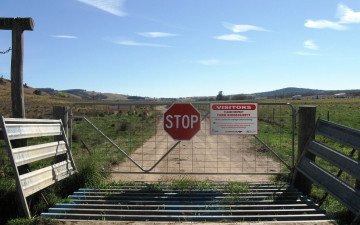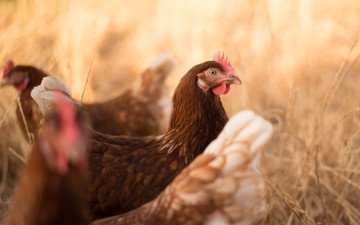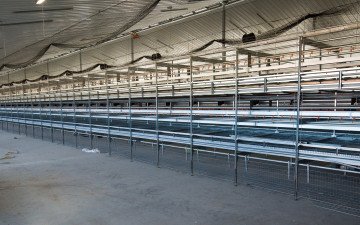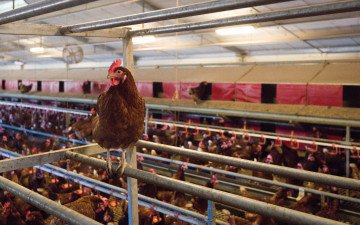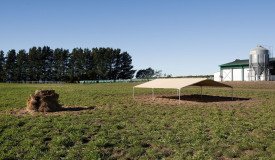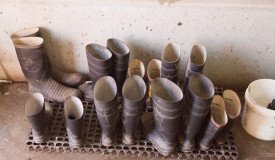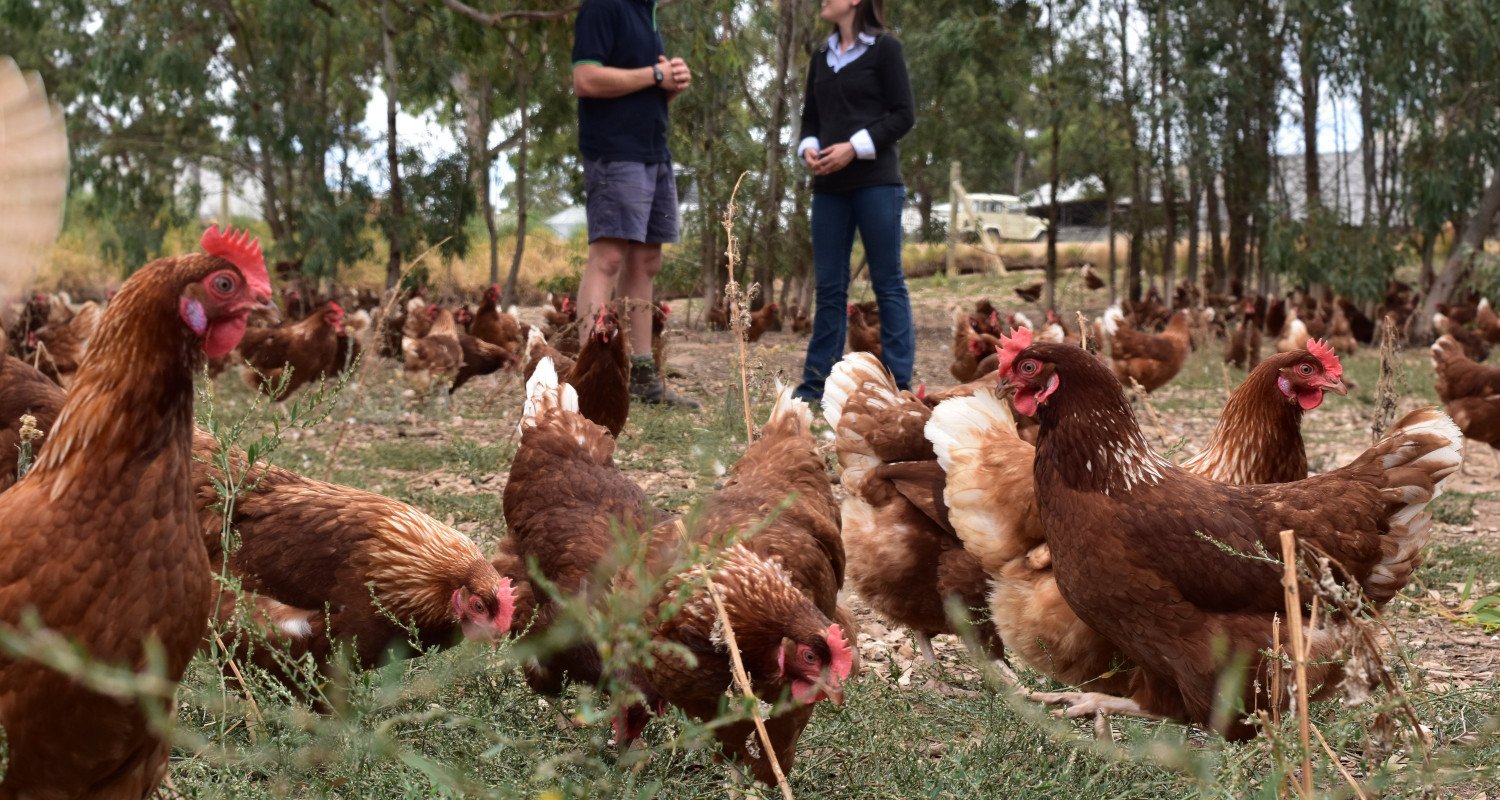
Leading Research: in Biosecurity & Flock Health
Maximising the health and productivity of hens is fundamental to maximising egg production and achieving satisfactory egg quality.
The increasing proportion of free range hens in recent years and the greater variability within free range production systems has the potential to impact the reliability of egg supply and consumer confidence.
Investment in R&D will focus on the investigation of short term, industry transferable solutions to hen disease and biosecurity threats, as well as long term research investigating the development of vaccines and therapeutic medicines to ensure that we are addressing more complex issues. The intended outcome is lower hen mortality rates, less and shorter breaks in production and consequently, increased productivity.
To assist the industry in maintaining strict biosecurity Australian Eggs has produced a range of resources to translate research learnings into helpful on-farm resources. The booklets can be downloaded below, or ordered in printed format from Australian Eggs.
Key Resources
Current Research

Genetic restoration to protect Australian poultry against Avian Influenza
The initial stage of research found the key in chicken genetics that is responsible for high pathogenic avian influenza virus. This project builds on this important finding, by testing the most appropriate and effective intervention to prevent low pathogenic avian influenza progressing to high pathogenic avian influenza.
Investigations of upper respiratory tract infections (URTI)
Upper respiratory tract infections are becoming increasingly common on egg farms costing the egg industry by way of vaccination, medication, and overall productivity losses.

Extension and communication strategies to improve biosecurity
This project will develop the most appropriate and applicable biosecurity extension and communications
strategies that will target small, medium and large segments of the egg industry.
Effect of microbiota seeding on gut health and egg production
Extending flocks productive lifespan has been a challenge for the egg industry and remains a priority. This project aims to investigate the “seeding” of gut with beneficial organisms as a potential layer hen
management strategy to improve the gut health of hens.
Decontamination project for the Australian poultry industry
In this jointly funded project, researchers will address knowledge gaps in current decontamination procedures in the broiler and layer industries. Researchers will develop a guideline comprised of everyday decontamination procedures, which will help to manage the risk of disease infecting and spreading within poultry flocks.

Optimising performance, health, flock consistency & egg quality characteristics through management
In this project, researchers will work with free range farms to understand the management factors which influence common problems in free range systems such as variable peak of lay timing and inconsistent egg size and quality.
Completed Research
Control of Intestinal Spirochaete Infections in Chickens
Infection of layer and broiler breeders with Avian Intestinal Spirochaetosis (AIS) has emerged as a widespread constraint to optimal production in both the egg and chicken meat industries in Australia.The micro-organisms involved are difficult to isolate and characterise, therefore diagnosis of AIS is often difficult.
Studies of Cloacal Haemorrhage, Vent Trauma and Beak Trimming in the Laying Hen
The long-term objective of this research program is to develop a world best practice to achieve peak egg production and to reduce mortalities to 2-3% in birds with intact beaks. .
Investigating Sanitation of Surface Water for Poultry using Chlorine-IBDV Models
Significant numbers of commercial poultry production sites in Australia rely on surface waters (dams, creeks and rivers) as their major source of drinking water.
Controlling Vent Trauma With Stockwound Sprays
Recent studies found that vent cannibalism was the biggest cause of loss in laying hens.Beak trimming, at two life stage intervals has been used as a means of controlling the problem.
Enhancing mucosal immunity in chickens
Infection in chickens caused by microbial pathogens at the intestinal surface can be a challenge for the Australian poultry industry.However, there are a number of novel vaccination strategies which can enhance antibody production and reduce the incidence of infection and ultimately improve flock health and performance.
Reducing Feather Pecking
This project aimed to improve feathering in laying hens by visually demonstrating (through video) the various bird behaviours that indicate positive and or negative outcomes.

Attenuation and characterisation of Eimeria spp
This purpose of this study was to isolate and purify field strains of E. Maxima and E. Acervulina for suitable use in a live poultry coccidiosis vaccine.
Marek's disease vaccine trials in commercial birds
This trial was undertaken to develop effective immunisation strategies for the prevention of Marek's disease using newer vaccines developed by RMIT Melbourne.
The significance of wet droppings in laying hens
The project was initiated due to numerous complaints from the industry egg producers regarding the issue of wet droppings and the hygienic implications this causes.The focus of the project was to examine wet litter problems from a nutritional perspective and to develop strategies minimising the problem.
Three vaccine trials on Marek's disease
The findings from three trials conducted to assess the efficacy of the newly developed RMIT vaccine against Marek's disease are detailed in the report on this project.
Evaluation of performance of tunnel ventilated layer housing
Competitive economic conditions mean that Australian egg producers seek ways to reduce the cost of egg production.Current housing design has proven unable to provide the economically optimum temperatures required by layers during winter and summer.
Development of Molecular Tests for Serovar-Specific Identification and Typing of Haemophilus paragallinarum
Haemophilus paragallinarum is the causative agent of infectious coryza, an upper respiratory tract disease of chickens characterised by relatively mild clinical signs.As there have been few studies on methods to type isolates of H.
Prevalence, genetic relationships and pathogenicity of intestinal spirochaetes infecting Australian poultry
This research aimed to: determine whether fastidious anaerobic intestinal spirochaetal bacteria, or a similar bacteria, was present in Australia; to isolate and characterise this bacteria; and to test the pathogenic potential of the disease.
Diagnosing Avian Respiratory Diseases
Respiratory diseases are a major cause of economic losses to the Australian chicken meat and egg industries.This study reports on the development of a quick new diagnostic process to identify two strains of respiratory disease.
Projects you might find interesting
Practical strategies to increase individual layer hens feed efficiency
The overall findings of this study reveal that significant variation exists in the feed efficiency of layer hens. In this project, hens that put on more weight from the point of lay to mid-lay tended to be less feed efficient and have poorer quality eggs. The high feed efficient hens had better egg quality and were less prone to liver damage or fatty liver.

Review of rodent control for the Australian chicken meat and egg industries
This final report on current rodent control strategies employed by the Australian chicken meat and egg industries also includes a manual for producers on use of rodenticide products.

Spotty Liver Disease Epidemiology
This project identified key risk factors for Spotty Liver Disease outbreak.

On-farm Biosecurity Risk Identification Framework for the Australian layer industry
This report provides a support tool for Australian egg producers to determine biosecurity risks on-farm. As well as assisting Egg producers in understanding what constitutes a risk and why, the report offers potential management strategies to decrease on-farm risks to biosecurity.
 >
> 





